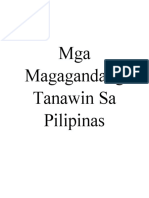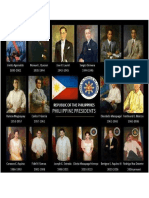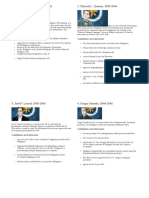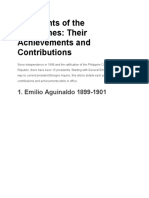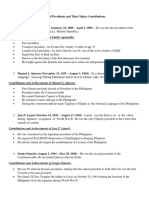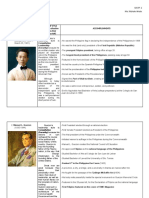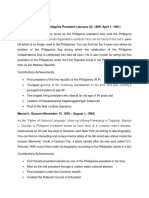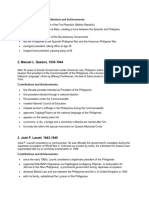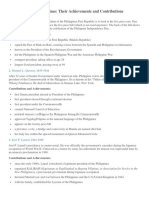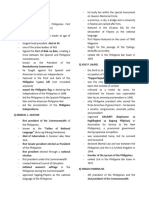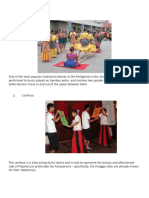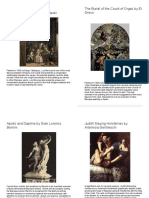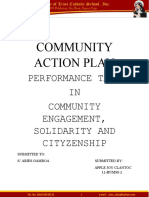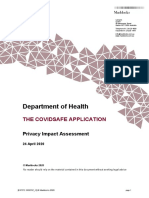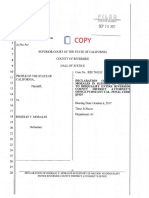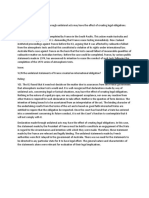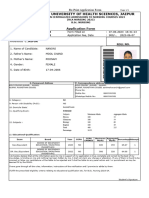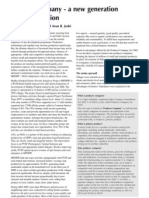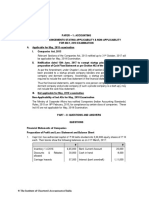93%(15)93% found this document useful (15 votes)
71K views17 President
The document summarizes the contributions and achievements of 9 presidents of the Philippines:
1. Emilio Aguinaldo - First president who declared Philippine independence in 1898.
2. Manuel Quezon - Second president and first under the Philippine Commonwealth, established Filipino as the national language.
3. Jose Laurel - Third president who served during the Japanese occupation of WWII.
4. Sergio Osmeña - Fourth president who succeeded Manuel Quezon and joined General MacArthur in liberating the Philippines.
5. Manuel Roxas - Fifth president, first of the Third Republic after WWII who focused on reconstruction.
6. Elpidio Quirino - Sixth president
Uploaded by
Kathy SarmientoCopyright
© © All Rights Reserved
We take content rights seriously. If you suspect this is your content, claim it here.
Available Formats
Download as DOCX, PDF, TXT or read online on Scribd
93%(15)93% found this document useful (15 votes)
71K views17 President
The document summarizes the contributions and achievements of 9 presidents of the Philippines:
1. Emilio Aguinaldo - First president who declared Philippine independence in 1898.
2. Manuel Quezon - Second president and first under the Philippine Commonwealth, established Filipino as the national language.
3. Jose Laurel - Third president who served during the Japanese occupation of WWII.
4. Sergio Osmeña - Fourth president who succeeded Manuel Quezon and joined General MacArthur in liberating the Philippines.
5. Manuel Roxas - Fifth president, first of the Third Republic after WWII who focused on reconstruction.
6. Elpidio Quirino - Sixth president
Uploaded by
Kathy SarmientoCopyright
© © All Rights Reserved
We take content rights seriously. If you suspect this is your content, claim it here.
Available Formats
Download as DOCX, PDF, TXT or read online on Scribd
You are on page 1/ 18
1.
Emilio Aguinaldo (January 23, 1899 – March 23,
1901)
Emilio Aguinaldo was the first president of the Philippines First Republic (also known as the
Malolos Republic). He was inaugurated on January 23, 1899, at the Barasoain Church, Malolos,
Bulacan. He led the proclamation of the Philippine Independence on June 12, 1898, in his
ancestral home in Kawit, Cavite.
Contributions and Achievements of Emilio Aguinaldo:
He waved the Philippine flag in declaring the independence of the
Philippines in 1898
He was the first (and only) president of the First Republic
(Malolos Republic)
The youngest Filipino president, taking office at age 28
The longest-lived president of the Philippines, passing away at
age 94
Featured in the front and back of the Philippine 5-peso bill (not
circulated anymore)
He led the country in the Spanish-Philippine War and the
American-Philippine War
He led the proclamation of the Philippine Independence
Known as the President of the Revolutionary Government
Signed the Pact of Biak-na-Bato, creating a truce between the
Spanish and Philippine revolutionaries
He was a well-known entrepreneur, soldier, and politician
Emilio Aguinaldo had Bachelor of Arts (college preparatory) at the
Colegio de San Juan de Letran in 1880
2. Manuel L. Quezon (1935-1944)
Manuel L. Quezon was the 2nd president of the Philippines and the first
president of the Philippine Commonwealth established under the USA. He
was inaugurated on December 30, 1941, in Corregidor Island. He’s known as
the “Father of National Language” (Ama ng Wikang Pambansa). He died of
tuberculosis in Saranac Lake, New York.
Contributions and Achievements of Manuel L. Quezon:
First President elected through a national election
First Senate President elected as President of the Philippines
The first president of the Philippines under the Commonwealth
Initiated women’s suffrage in the Philippines during the Commonwealth
Manuel L. Quezon created the National Council of Education
He approved Filipino as the national language of the Philippines
Studied Bachelor of Arts at Colegio de San Juan de Letran
Studied Bachelor of Law at the University of Sto. Tomas
Ranked 4th in the Philippine Bar Exam (1903)
A province, a city, a bridge, and a university in Manila are named after
him
He fought for the passage of the Tydings-McDuffie Act (1934)
His body rests peacefully inside the special monument on Quezon
Memorial Circle
Featured in the 20-peso bill, for the Declaration of Filipino as the
national language
First Filipino featured on the cover of TIME Magazine
3. Jose P. Laurel (October 14, 1943 – August 17,
1945)
Jose P. Laurel was the 3rd president of the Philippines and the president of the
Second Philippine Republic. His inauguration was on October 14, 1943, in the
Legislative Building, now National Museum. He served president of the
Philippines during the Japanese occupation during World War II.
Contributions and Achievements of Jose P. Laurel:
Jose P. Laurel is the only Philippine president who served the
three branches of government – he became a senator-
congressman, associate justice, and president
Since the early 1960s, Laurel was recognized as a legitimate
president of the Philippines
Organized KALIBAPI (Kapisanan sa Paglilingkod sa Bagong
Pilipinas, or Association for Service to the New Philippines), a
provisional government during the Japanese occupation
Laurel declared Martial Law and war between the Philippines and
the US/United Kingdom in 1944
He’s the Founder of the Lyceum of the Philippines
He’s a Law genius, ranked 2nd in the Philippine Bar Exam in
1915
Earned a Doctorate in Civil Law from Yale University in 1920
Received Honoris Causa from Tokyo Imperial University in
1938
He was assassinated twice, but he survived and recovered
4. Sergio Osmeña Sr. (August 1, 1944 – May 28,
1946)
Sergio Osmeña Sr. was the 4th president of the Philippines and the
2nd president of the Commonwealth. He was inaugurated on August 1, 1944, in
Washington DC. He succeeded the presidency after the death of then
president Manuel L. Quezon. During his administration, the Philippines joined
the International Monetary Fund.
Contributions and Achievements of Sergio Osmena:
Sergio Osmeña was the first Visayan to become
president, born in Cebu City
He joined with U.S. Gen. Douglas McArthur in Leyte on October
20, 1944, to begin restoration of Philippine freedom after
Japanese occupation
Founder of the Nacionalista Party
Philippine National Bank was rehabilitated, and the country
joined the International Monetary Fund during his presidency
The U.S. Congress approved the Bell Trade Act during his
presidency
He was 2nd placer in the 1903 Philippine Bar Exam
Founder and Editor of a Spanish newspaper, El Nuevo Dia, in
Cebu City
Had Bachelor of Arts from Colegio de San Juan de Letran (1894)
Had Bachelor of Law from the University of Santo Tomas (1903)
Featured in the 50-peso bill, First Philippine Assembly, Leyte
Landing
5. Manuel A. Roxas (May 28, 1946 – April 15, 1948)
Manuel Roxas was the 5th president of the Philippines, the 3rd (and last)
president under the Commonwealth, and the first president of the Third
Republic of the Philippines. He was inaugurated on May 28, 1946, at the
National Museum building. He held office for only one year, 10 months, and
18 days.
Contributions and Achievements of Manuel Roxas:
Manuel Roxas was inaugurated as the first president of the New
Republic after World War II
Reconstruction from war damage and life without foreign
rule began during his presidency
Congress accepted the Philippine Rehabilitation Act and
Philippine Trade Act laws under his term
Ranked 1st Place in the Philippine Bar Exam (1913)
Featured in the 100-peso bill, Old Bangko Sentral ng Pilipinas
building in Intramuros, Manila, Inauguration of the Third Philippine
Republic
6. Elpidio R. Quirino (April 17, 1948 – December
30, 1953)
Elpidio Quirino was the 6th president of the Philippines and the 2nd president of
the Third Republic. He succeeded presidency after incumbent president
Manuel Roxas died in 1948. Quirino was 57 years old when he was
inaugurated as president on April 17, 1948, at the Malacañang Palace.
Contributions and Achievements of Elpidio Quirino:
Hukbalahap Guerrilla movement was active during his presidency
He created the Social Security Commission
He created the Integrity Board to monitor graft and corruption
During his term, Quezon City became capital of the Philippines in 1948
Completed Bachelor of Law at the University of the Philippines in 1915
Dean of the College of Law at the Adamson University (1941-1946)
Ranked 2nd placer in the Philippine Bar Exam in 1915
7. Ramon Magsaysay Sr. (December 30, 1953 –
March 17, 1957)
Ramon Magsaysay was the 7th president of the Philippines and the
3rd president of the Third Republic. He was the first president who sworn into
the office wearing Barong Tagalog during the inauguration. He died in an
aircraft disaster while boarding the presidential plane.
Contributions and Achievements of Ramon Magsaysay:
He led to defeat the Hukbalahap movement
Chairman of the Committee on Guerrilla Affairs
His presidency was referred to as the Philippines’ “Golden Years”
for its lack of corruption
The Philippines was ranked second in Asia’s clean and well-
governed countries during his presidency
He established the National Resettlement and Rehabilitation
Administration (NARRA) among other agrarian reforms
He made the Philippine a member of the Southeast Asia Treaty
Organization
8. Carlos P. Garcia (March 18, 1957 – December
30, 1961)
Carlos P. Garcia is the 8th president of the Philippines and fourth president of
the Third Republic. This Bohol native was a lawyer, poet, and professor and
served as a guerrilla leader during the Pacific War. Garcia served as vice
president under Ramon Magsaysay and as secretary of Foreign Affairs for
four years. He became president when Magsaysay died in a plane crash in
1957.
Contributions and Achievements of Carlos P. Garcia:
Carlos P. Garcia was known for promoting “Filipino First Policy,”
which favored Filipino businesses over foreign investors
He established the Austerity Program focusing on Filipino trade
and commerce
He became a famous poet and known as the “Prince of Visayan
Poets” and the “Bard from Bohol.”
Cultural arts was revived during his term
He was the first president to have his remains buried at
the Libingan ng mga Bayani
He achieved 7th placer in the Philippine Bar Exam in 1923
9. Diosdado P. Macapagal (December 30, 1961 –
December 30, 1965)
Diosdado P. Macapagal was the 9th president of the Philippines. He was a
lawyer and economist, born in Lubao, Pampanga. He was inaugurated on
December 30, 1961, at the Quirino Grandstand. His daughter, Gloria
Macapagal Arroyo, followed his path and became president, too.
Contributions and Achievements of Diosdado
Macapagal:
Topped the Bar Exam, 1st place in 1936
Took a Master of Law in 1941 and Doctor of Civil Law in 1947,
and a Ph.D. in Economics in 1957
Diosdado Macapagal was a great economist, he established the
first Land Reform Law, allowing for the purchase of private
farmland to be distributed in inexpensive, small lots to the
landless
He placed the Philippine peso on the free currency exchange
market and encouraged exports
The Philippine representative to the United Nations General
Assembly three times
He signed the Minimum Wage Law
Diosdado Macapagal signed the law to create the Philippine
Veteran’s Bank
Featured in the 200-peso bill
10. Ferdinand E. Marcos (December 30, 1965 –
February 25, 1986)
Ferdinand Marcos was the tenth president of the Philippines and the last
president of the Third Republic. He was one of the most controversial leaders
of the 20th century. He ruled the Philippines for 21 years and was removed
from office after the People Power Revolution.
Contributions and Achievements of Ferdinand Marcos:
The first president to win a second term
The longest-ruling president of the Philippines, he ruled for 21 years
He declared Martial Law on Sept. 22, 1972
He increased the size of Philippine military and armed forces
By 1980, the Philippine GNP was four times greater than 1972
Marcos built more schools, roads, bridges, hospitals, and other infrastructure
than all former presidents combined
He topped 1st place in the Bar Exam in 1939
The only president whose remains were interred inside a refrigerated crypt
Many of Marcos Sr.’s infrastructure projects include the North Luzon
Expressway, South Luzon Expressway, Maharlika Highway, Circumferential
Roads 1-10, San Juanico Bridge, and Mactan-Mandaue Bridge
Ferdinand Marcos Sr.’s government also completed 20 power plants so that the
Philippines would be independent of the surging prices of oil and electricity
Notable medical institutions were also built during Marcos’s regime, such as the
Philippine Heart Center, Lung Center of the Philippines, and National Kidney and
Transplant Institute
The Cultural Center of the Philippines (CCP), Folks Arts Theater, Philippine
International Convention Center (PICC), National Arts Center, Nayong Pilipino,
and the People’s Park in the Sky were constructed during Marcos Sr.’s regime to
promote Filipino heritage and culture
Marcos Sr. signed the Emancipation of Tenants from the Bondage of the
Soil (Presidential Decree No.27) in 1972
11. Corazon C. Aquino (February 25, 1986 – June
30, 1992)
Corazon Aquino was the first woman president of the Philippines and the first
woman to become president of an Asian country. She was the 11th president
and a democracy icon, one of the 100 Women Who Shaped World History
and 20 Most Influential Asians of the 20th Century.
Contributions and Achievements of Corazon Aquino:
The first woman to be president of the Philippines or
any Asian country
She signed the Family Code of 1987, a major civil law reform,
and 1191 Local Government Code, which reorganized the
structure of the executive branch of government
She initiated charitable and social activities helping the poor and
the needy
Was named “Woman of the Year” in 1986 by TIME magazine
She was featured on the new 500-peso bill together with her
husband, Benigno Aquino Jr.
Among the 100 Women Who Shaped World History
One of the 20 Most Influential Asians of the 20th Century
One of TIME Magazine’s 65 Asian Heroes
Received Honorary Doctorates from international universities
including Boston University, Eastern University in Pennsylvania,
Fordham University in New York, Waseda University in Tokyo
12. Fidel V. Ramos (June 30, 1992 – June 30, 1998)
Fidel Ramos was the 12th president of the Philippines. Ramos also lived longer
than the other presidents. Like Aguinaldo, FVR was 94 years old when he
died. He’s one of the most admired presidents because, during his
presidency, he restored economic growth and stability in the country.
Contributions and Achievements of Fidel V. Ramos:
FVR was widely credited as the most effective
president because he led the Philippines to economic growth
He promoted family-planning practices to help to solve the
country’s growing population
Hosted the 4th Asia Pacific Economic Cooperation Leader’s
Summit in the Philippines in 1996
He presided over celebrations of Philippine
Independence Centennial in 1998
Ramos reached out peace talks with the rebels such as the Moro
National Liberation Front and New People’s Army
FVR received British Knighthood from Her Majesty Queen
Elizabeth II (Knight Grand Cross of the Order of St. Michael and
St. George)
The Philippine Stock Exchange became an international favorite
during his presidency
Ranked 8th Place in the Philippine Civil Engineering Licensure
Exam (1953)
The death penalty was reinstated while he was in office
FVR was the only military officer who reached the rank of five-
star general/admiral de jure who rose from second lieutenant up
to commander-in-chief of the armed forces
Had 29 Honorary Doctorate Degrees
13. Joseph E. Estrada (June 30, 1998 – January
20, 2001)
Joseph Estrada is the 13th president of the Philippines and the first film actor to
become a president in the country. During his years in office, economic
growth was slow, and he faced impeachment proceedings. He became the
first president in Asia to be impeached from an executive role. He was ousted
from the presidency in 2001.
Contributions and Achievements of Joseph Estrada:
He starred in over 100 films in the Philippines and received
numerous Best Actor awards
Moro Islamic Liberation Front headquarters and camps were
captured during his presidency
Cited as one of the Three Outstanding Senators in 1989
He became a Mayor of the City of Manila, the county’s capital
He won every mayor election in San Juan from 1969 to 1984
Erap was among the “Magnificent 12” who voted to terminate the
agreement that allows for U.S. control of Clark Airbase and Subic
Naval Base
He was credited with the passage of, among other pieces of
legislation, the bills on irrigation project and the protection of
carabaos
14. Gloria Macapagal Arroyo (January 20, 2001 – June
30, 2010)
Gloria Macapagal Arroyo is the 14th president of the Philippines, the 2nd female president,
and the first Filipino president whose parent was a former president. She’s also an
economist like her father, ex-president Diosdado Macapagal. Having a master’s degree
and doctorate in economics, Gloria put the Philippine economy back in shape.
Contributions and Achievements of Gloria Macapagal
Arroyo:
Second female president of the country
First president to take oath outside Luzon
Gloria Arroyo oversaw higher economic growth than the past three
presidents before her
Philippine Peso became the best-performing currency of the year in
Asia in 2007 during her term
eVAT Law was implemented under her term
She supported to bring back Spanish language in the Philippines during
her 9-year presidency
She took up International Trade at Georgetown University in Washington
D.C. with Bill Clinton
Graduated Magna Cum Laude from Assumption College in 1968
Arroyo earned a Master’s Degree in Economics from Ateneo de Manila
University in 1978
Obtained Doctorate in Economics from the University of the
Philippines in 1986
Numerous Honorary Degrees granted by prominent international
universities
TIME Magazine’s People Who Mattered list for 2005
Forbes 100 Most Powerful Women in the World (2004 – 2009)
Currently featured on the 200-peso bill
15. Benigno Aquino III (June 30, 2010 – June 30,
2016)
Benigno Aquino III was the 15th president of the Philippines. He was the first
bachelor president. A son of ex-president Corazon Aquino, he was also called
as Noynoy or PNoy. Noynoy finished his Economics degree from Ateneo de
Manila University. He was one of the students of a former economics
professor, Gloria Macapagal Arroyo, the president before him.
Contributions and Achievements of Benigno Aquino III:
He created the no “wang-wang” (street siren) policy
Noynoy initiated shifting to K-12 education in the Philippines
Peace agreement with the Moro Islamic Liberation Front in
October 2012
Oversaw 7.1% growth of the Philippine economy in 2012
TIME named him one of the 100 Most Influential People in the
World in 2013
16. Rodrigo Roa Duterte (June 30, 2016 – June 30,
2022)
Photo Credit: DuterteUpdates Instagram
Rodrigo Roa Duterte is the 16th president of the Philippines. He’s one of the
most loved presidents. He’s earned a massive fanbase after transforming one
of the most dangerous cities (Davao) into one of the world’s safest when he
was a mayor. At age 71, he became the oldest Filipino ever elected to the
presidency.
Contributions and Achievements of Rodrigo Duterte:
He earned Political Science Degree from Lyceum of the
Philippines in 1968
Obtained Law Degree from San Beda College in 1972
He initiated decongesting the Ninoy Aquino International
Airport in Manila, the country’s main gateway
Signed the Freedom of Information Order
Duterte launched a 24-hour complaint hotline, 8888
He signed an order for Smoking Ban in public places
Boracay Island was rehabilitated during his term
Launched the Build! Build! Build! Infrastructure Program
Duterte signed the TRAIN Law and Comprehensive Tax Reform
Program
One of Forbes list of World’s Most Powerful People in 2016
Duterte has been featured on the cover of TIME Magazine
17. Ferdinand R. Marcos Jr. (June 30, 2022 –
present)
Ferdinand R. Marcos Jr. is the 17th president of the Philippines. He is the
second child of former president Ferdinand Edralin Marcos and the “iron
butterfly” Imelda Romualdez Marcos. His campaign is focused on unity. BBM
won the presidential election by a landslide garnering over 31 million votes.
Contributions and Achievements of Ferdinand R.
Marcos Jr:
BBM has been a public servant since 1980
He served as a senator, congressman, governor, and vice-
governor
Marcos Jr. authored landmark laws such as the Philippine
Archipelagic Baselines Law (R.A. 9522)
He authored, co-authored, sponsored, and co-sponsored 54 bills
passed into law
BBM led the modernization of agricultural and tourism landscape
of Ilocos Norte when he was a governor
BBM is an advocate of renewable energy and sustainable
development, the Bangui Windmill Farm was one of his
astonishing energy development projects
You might also like
- Presidents of The Philippines and Their Achievements and Contributions86% (7)Presidents of The Philippines and Their Achievements and Contributions17 pages
- Tennessee Lawsuit Challenges Sex Offender Registry Laws100% (3)Tennessee Lawsuit Challenges Sex Offender Registry Laws56 pages
- Presidents of The Philippines and Their Achievements and ContributionsNo ratings yetPresidents of The Philippines and Their Achievements and Contributions12 pages
- 2.) Presidents of The Philippines Their Programs and Projects and Its Significant Accomplishments and Contributions100% (3)2.) Presidents of The Philippines Their Programs and Projects and Its Significant Accomplishments and Contributions26 pages
- Presidents of The Philippines From Past To Present100% (1)Presidents of The Philippines From Past To Present23 pages
- List of President of The Philippines and Their Achievements and Contributions100% (1)List of President of The Philippines and Their Achievements and Contributions26 pages
- Presidents of The Philippines From Past To Present75% (8)Presidents of The Philippines From Past To Present16 pages
- Philippine Presidents in The Philippines and Their Contributions To The Country100% (4)Philippine Presidents in The Philippines and Their Contributions To The Country3 pages
- Presidents of The Philippines From Past To PresentNo ratings yetPresidents of The Philippines From Past To Present3 pages
- Presidents of The Philippines - Docx Version 1No ratings yetPresidents of The Philippines - Docx Version 15 pages
- Emilio Aguinaldo 1899-1901: 2. Manuel L. Quezon, 1935-1944No ratings yetEmilio Aguinaldo 1899-1901: 2. Manuel L. Quezon, 1935-19446 pages
- Complete List of Presidents of The Philippines (Philhist)No ratings yetComplete List of Presidents of The Philippines (Philhist)9 pages
- The History of President of Republic of The PhilippinesNo ratings yetThe History of President of Republic of The Philippines50 pages
- Presidents of The Philippines and Their Contributions0% (2)Presidents of The Philippines and Their Contributions12 pages
- Philippine Presidents - Their Achievements and Contributions - INFINITHINKNo ratings yetPhilippine Presidents - Their Achievements and Contributions - INFINITHINK12 pages
- Emilio Aguinaldo 1899-1901: Contributions and AchievementsNo ratings yetEmilio Aguinaldo 1899-1901: Contributions and Achievements16 pages
- List of Presidents and Their Major Contributions100% (1)List of Presidents and Their Major Contributions8 pages
- Presidents of The Philippines and Their Achievements100% (1)Presidents of The Philippines and Their Achievements9 pages
- Presidents of The Philippines and Their Achievements and ContributionsNo ratings yetPresidents of The Philippines and Their Achievements and Contributions19 pages
- Presidents of The Philippines: Their Achievements and Contributions0% (1)Presidents of The Philippines: Their Achievements and Contributions14 pages
- Presidents of The Philippines: Their Achievements and ContributionsNo ratings yetPresidents of The Philippines: Their Achievements and Contributions4 pages
- The 17 President of The Philippine RepublicNo ratings yetThe 17 President of The Philippine Republic6 pages
- Gonzales, Joshua H. - ARCH2A - NSTP2-i-ConnectNo ratings yetGonzales, Joshua H. - ARCH2A - NSTP2-i-Connect11 pages
- Presidents of The Philippines and Their Achievements and ContributionsNo ratings yetPresidents of The Philippines and Their Achievements and Contributions7 pages
- Emilio Aguinaldo-1 Philippine President (January 23, 1899 - April 1, 1901)No ratings yetEmilio Aguinaldo-1 Philippine President (January 23, 1899 - April 1, 1901)11 pages
- EMELIO AGUINALDO Contributions and AchievmentsNo ratings yetEMELIO AGUINALDO Contributions and Achievments6 pages
- Name: Jaica M. Tabugara Yr. & Sec.: Beed 2ANo ratings yetName: Jaica M. Tabugara Yr. & Sec.: Beed 2A7 pages
- Presidents of The Philippines: Their Achievements and ContributionsNo ratings yetPresidents of The Philippines: Their Achievements and Contributions9 pages
- Most Famous Paintings of The RenaissanceNo ratings yetMost Famous Paintings of The Renaissance4 pages
- Course Unit 7 Summary of The Different Basic Statistical Tests II ANOVA - 786498536No ratings yetCourse Unit 7 Summary of The Different Basic Statistical Tests II ANOVA - 7864985366 pages
- Research Proposal - Roles of Sangguniang Kabataan of Barangay General Luna Zaragoza Nueva Ecija in Crime Prevention50% (2)Research Proposal - Roles of Sangguniang Kabataan of Barangay General Luna Zaragoza Nueva Ecija in Crime Prevention25 pages
- The Royal Alpha Omega King Trading CorporationNo ratings yetThe Royal Alpha Omega King Trading Corporation2 pages
- Name:John Kevin Ignacio Age: 15 Yrs Old Location: Entablado Cabiao Nueva Ecija Fb:John Kevin Ignacio Internet: Wifi or Data Device: Android86% (7)Name:John Kevin Ignacio Age: 15 Yrs Old Location: Entablado Cabiao Nueva Ecija Fb:John Kevin Ignacio Internet: Wifi or Data Device: Android3 pages
- Howell Howell: QTY Unit Articles UP Amount QTY Unit Articles UP AmountNo ratings yetHowell Howell: QTY Unit Articles UP Amount QTY Unit Articles UP Amount1 page
- Covidsafe Application Privacy Impact Assessment100% (1)Covidsafe Application Privacy Impact Assessment78 pages
- Rogelio V. Morales' Motion To Disqualify Riverside County District Attorney From His Criminal Case100% (1)Rogelio V. Morales' Motion To Disqualify Riverside County District Attorney From His Criminal Case41 pages
- Candelario vs. Candelario G.R. No 222068No ratings yetCandelario vs. Candelario G.R. No 22206816 pages
- Innovation Management and New Product Development 7th Edition Paul Trott pdf downloadNo ratings yetInnovation Management and New Product Development 7th Edition Paul Trott pdf download45 pages
- THINGS I LEARNT ABOUT BEING A BETTER COUNSEL FROM ACTINGNo ratings yetTHINGS I LEARNT ABOUT BEING A BETTER COUNSEL FROM ACTING9 pages
- Online RTE Reservation 2021-2022: Application DetailsNo ratings yetOnline RTE Reservation 2021-2022: Application Details2 pages
- Medical Journal of Australia - 2023 - Ferson - Cremation and The Medical PractitionerNo ratings yetMedical Journal of Australia - 2023 - Ferson - Cremation and The Medical Practitioner2 pages
- Sony - DPT - S1 - Digital - Paper - Cloud - Storage - Configuration - GuideNo ratings yetSony - DPT - S1 - Digital - Paper - Cloud - Storage - Configuration - Guide6 pages
- United States v. Alfredo Aviles, Charles Barcellona, Jean Capece, Charles Di Palermo, Joseph Di Palermo, Natale Evola, Vito Genovese, Vincent Gigante, Daniel Lessa, Nicholas Lessa, Rocco Mazzie, Carmine Polizzano, Ralph Polizzano, Benjamin Rodriquez, and Salvatore Santora, 274 F.2d 179, 2d Cir. (1960)100% (1)United States v. Alfredo Aviles, Charles Barcellona, Jean Capece, Charles Di Palermo, Joseph Di Palermo, Natale Evola, Vito Genovese, Vincent Gigante, Daniel Lessa, Nicholas Lessa, Rocco Mazzie, Carmine Polizzano, Ralph Polizzano, Benjamin Rodriquez, and Salvatore Santora, 274 F.2d 179, 2d Cir. (1960)21 pages
- What You Need To Know About Labour Law On Labour Day by Isaac Christopher LubogoNo ratings yetWhat You Need To Know About Labour Law On Labour Day by Isaac Christopher Lubogo41 pages
- Open Records Response - Matt Brown (10.6.20)No ratings yetOpen Records Response - Matt Brown (10.6.20)102 pages
- Subpoena To Produce Documents, Information, or Objects or To Permit Inspection of Premises in A Civil Action100% (1)Subpoena To Produce Documents, Information, or Objects or To Permit Inspection of Premises in A Civil Action35 pages
- United States of America Ex Rel. Howard J. Vivian, Jr. v. Saul Bookbinder, Warden Holmesburg Prison, 403 F.2d 156, 3rd Cir. (1969)No ratings yetUnited States of America Ex Rel. Howard J. Vivian, Jr. v. Saul Bookbinder, Warden Holmesburg Prison, 403 F.2d 156, 3rd Cir. (1969)5 pages



